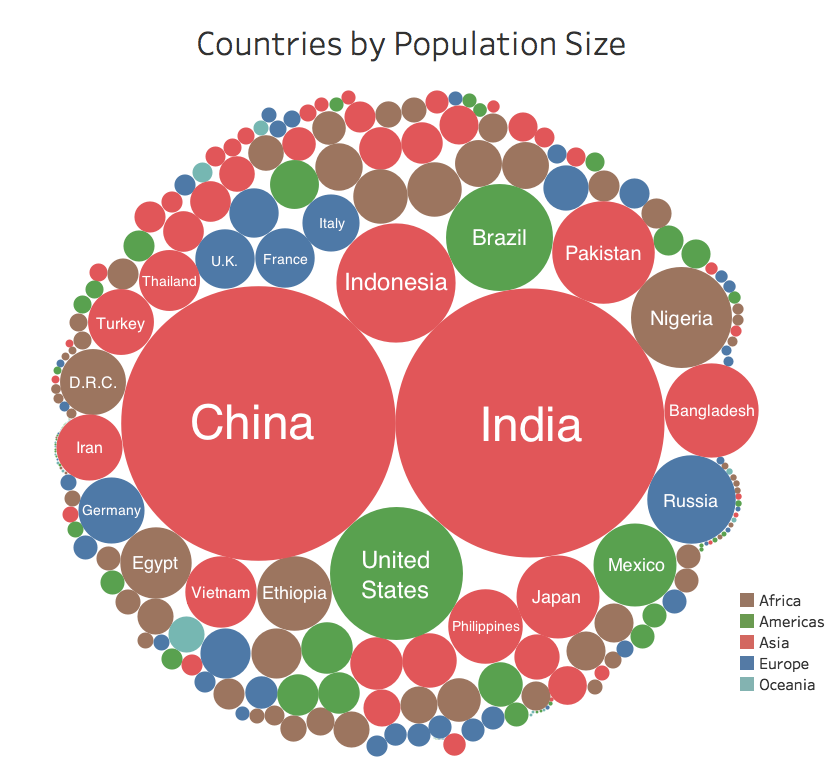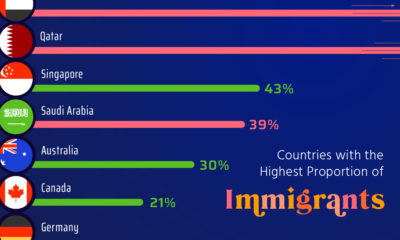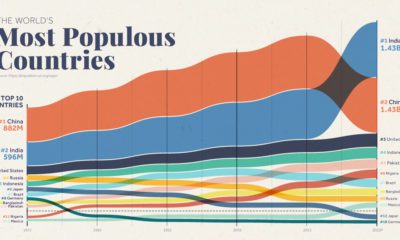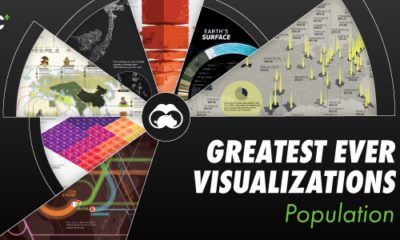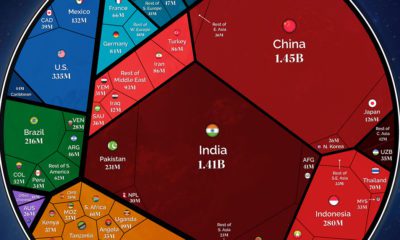It’s a very simple question, but it’s also hard to get an accurate sense of the answer by browsing through a lengthy table of country-level population data. That’s because there are close to 200 countries spread around the globe, with populations ranging from near 1.4 billion (China or India) to countries a mere 0.001% of that size. How is it possible to do the mental math in interpreting such a wide range of data points simultaneously?
Visualizing the World’s Population
Today’s data visualization comes to us from PopulationPyramid.net, a fantastic resource for data on global population numbers. It allows us to see the location of the world’s 7.5 billion people by resizing countries based on their populations and then coloring and organizing them by region. This simple application of data visualization makes it more intuitive to comprehend where people live around the globe, as well as how different countries compare in size.
Regional Populations
The first thing you might notice on the graphic is the relative size of regions, with Asia taking up a whopping 60% of the visual space. Here are those numbers by region broken down further: When you look at it this way, you can really see how the math breaks down. About 75% of people reside in Asia or Africa. Meanwhile, the regions of Europe, North America, South America, and Oceania just total together to 25% of the mix.
The 10 Most Populous Countries
There are some countries that are clear standouts on the data visualization. For example, China and India combine to 2.7 billion people, together accounting for 36% of the total global population. Those heavyweights aside, there are other notable countries that take up significant amounts of real estate on the visualization as well: The United States, Indonesia, Brazil, and Pakistan rank between #3 and #6, and have about a billion people between them. Nigeria, which is #7 on the list, has the world’s fastest growing megacity within its borders. Further, Bangladesh is also a noteworthy entry since it is one of the densest populations globally, with 1,138.9 people per square kilometer of land.
A Final Look at Global Population
This isn’t the first time we’ve shown you a data visualization that organizes the global population – here’s one we previously published that shows each country in a bubble chart:
While this uses slightly older data, it is still interesting to see how data visualization can help us understand a complex and wide-ranging set of data that is relevant to everyday life. on Even while political regimes across these countries have changed over time, they’ve largely followed a few different types of governance. Today, every country can ultimately be classified into just nine broad forms of government systems. This map by Truman Du uses information from Wikipedia to map the government systems that rule the world today.
Countries By Type of Government
It’s important to note that this map charts government systems according to each country’s legal framework. Many countries have constitutions stating their de jure or legally recognized system of government, but their de facto or realized form of governance may be quite different. Here is a list of the stated government system of UN member states and observers as of January 2023: Let’s take a closer look at some of these systems.
Monarchies
Brought back into the spotlight after the death of Queen Elizabeth II of England in September 2022, this form of government has a single ruler. They carry titles from king and queen to sultan or emperor, and their government systems can be further divided into three modern types: constitutional, semi-constitutional, and absolute. A constitutional monarchy sees the monarch act as head of state within the parameters of a constitution, giving them little to no real power. For example, King Charles III is the head of 15 Commonwealth nations including Canada and Australia. However, each has their own head of government. On the other hand, a semi-constitutional monarchy lets the monarch or ruling royal family retain substantial political powers, as is the case in Jordan and Morocco. However, their monarchs still rule the country according to a democratic constitution and in concert with other institutions. Finally, an absolute monarchy is most like the monarchies of old, where the ruler has full power over governance, with modern examples including Saudi Arabia and Vatican City.
Republics
Unlike monarchies, the people hold the power in a republic government system, directly electing representatives to form government. Again, there are multiple types of modern republic governments: presidential, semi-presidential, and parliamentary. The presidential republic could be considered a direct progression from monarchies. This system has a strong and independent chief executive with extensive powers when it comes to domestic affairs and foreign policy. An example of this is the United States, where the President is both the head of state and the head of government. In a semi-presidential republic, the president is the head of state and has some executive powers that are independent of the legislature. However, the prime minister (or chancellor or equivalent title) is the head of government, responsible to the legislature along with the cabinet. Russia is a classic example of this type of government. The last type of republic system is parliamentary. In this system, the president is a figurehead, while the head of government holds real power and is validated by and accountable to the parliament. This type of system can be seen in Germany, Italy, and India and is akin to constitutional monarchies. It’s also important to point out that some parliamentary republic systems operate slightly differently. For example in South Africa, the president is both the head of state and government, but is elected directly by the legislature. This leaves them (and their ministries) potentially subject to parliamentary confidence.
One-Party State
Many of the systems above involve multiple political parties vying to rule and govern their respective countries. In a one-party state, also called a single-party state or single-party system, only one political party has the right to form government. All other political parties are either outlawed or only allowed limited participation in elections. In this system, a country’s head of state and head of government can be executive or ceremonial but political power is constitutionally linked to a single political movement. China is the most well-known example of this government system, with the General Secretary of the Communist Party of China ruling as the de facto leader since 1989.
Provisional
The final form of government is a provisional government formed as an interim or transitional government. In this system, an emergency governmental body is created to manage political transitions after the collapse of a government, or when a new state is formed. Often these evolve into fully constitutionalized systems, but sometimes they hold power for longer than expected. Some examples of countries that are considered provisional include Libya, Burkina Faso, and Chad.
